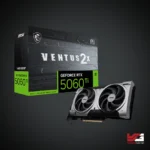
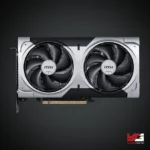
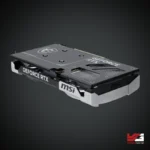
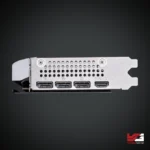
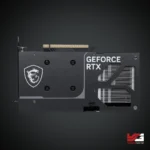
₨ 183,000
- Powered by the NVIDIA Blackwell architecture and DLSS 4
- Core Clock:
- Extreme Performance: 2617 MHz (MSI Center)
- Boost: 2602 MHz
- STORMFORCE FAN: Seven fan blades, claw texturing, and a circular arc are designed for optimal airflow with minimal noise.
- Heat Pipes designed for efficient heat transfer, the heat pipes effectively draw thermal energy away from the GPU, improving overall cooling performance.
- Metal Backplate: A sturdy metal backplate strengthens the graphics card while the airflow vent design reduces excess heat.
- MSI Center: The exclusive MSI Center software lets you monitor, tweak and optimize MSI products in real-time.
- Afterburner software takes full control with the most recognized and widely used graphics card overclocking software in the world.
In stock
RELATED PRODUCTS
ASUS DUAL GEFORCE RTX 3050 V2 OC EDITION 8GB GDDR6 GRAPHIC CARD
NVIDIA Ampere Architecture – Delivers enhanced performance and efficiency with 2560 CUDA cores and advanced technologies.
8GB GDDR6 Memory – Provides ample high-speed memory for high-resolution textures and demanding games.
Compact 2-Slot Design – Ensures compatibility with smaller chassis without sacrificing performance.
Axial-Tech Fan Design – Features longer blades and a barrier ring to increase downward air pressure for improved cooling.
Auto-Extreme Technology and Stainless Steel Bracket – Ensures precision manufacturing and structural durability.
In Stock
MSI GeForce GT N730 4GD3 V2 Graphic Card
- GPU & Performance: Powered by NVIDIA GeForce GT 730, offering basic graphics performance for everyday computing and multimedia tasks
- Memory Support: Features 4GB DDR3 VRAM with a 64-bit memory interface, ensuring smooth video playback and multitasking
- Display Connectivity: Equipped with HDMI, DVI-D, and VGA ports, supporting multi-monitor setups and HD video output
- Power Efficiency: Runs on low power consumption, requiring no external power connector, making it ideal for small form factor (SFF) builds
- Cooling & Silent Operation: Utilizes a passive cooling design, ensuring silent operation, perfect for office and home environment
- Compact & Durable Design: Built with MSI’s quality components, offering stability, longevity, and easy installation for system upgrades
In stock
ASUS DUAL GEFORCE RTX™ 4060 TI EVO OC EDITION 16GB GDDR6 GRAPHIC CARD
NVIDIA Ada Lovelace Architecture – Delivers enhanced performance and efficiency with 4352 CUDA cores and advanced technologies.
16GB GDDR6 Memory – Provides ample high-speed memory for high-resolution textures and demanding applications.
Compact 2.5-Slot Design – Ensures compatibility with various chassis without sacrificing performance.
Axial-Tech Fan Design – Features longer blades and a barrier ring to increase downward air pressure for improved cooling.
Auto-Extreme Technology and Protective Backplate – Ensures precision manufacturing and structural durability.
ASUS DUAL GEFORCE RTX™ 4070 SUPER EVO 12GB GDDR6X GRAPHIC CARD
NVIDIA Ada Lovelace Architecture – Delivers enhanced performance and efficiency with 7168 CUDA cores and advanced technologies.
12GB GDDR6X Memory – Provides ample high-speed memory for high-resolution textures and demanding applications.
Compact 2.5-Slot Design – Ensures compatibility with various chassis without sacrificing performance.
Axial-Tech Fan Design – Features longer blades and a barrier ring to increase downward air pressure for improved cooling.
Auto-Extreme Technology and Protective Backplate – Ensures precision manufacturing and structural durability.
ASUS PROART GEFORCE RTX 4080 SUPER OC 16GB – GRAPHICS CARD
NVIDIA Ada Lovelace Architecture – Delivers enhanced performance and efficiency with 10,240 CUDA cores and advanced technologies.
16GB GDDR6X Memory – Provides ample high-speed memory for high-resolution textures and demanding applications.
Compact 2.5-Slot Design – Ensures compatibility with various chassis without sacrificing performance.
Axial-Tech Fan Design – Features longer blades and a barrier ring to increase downward air pressure for improved cooling.
Auto-Extreme Technology and Protective Backplate – Ensures precision manufacturing and structural durability.
MSI GeForce RTX 5060 TI VENTUS 2X 16G OC PLUS Price In Pakistan:
Comprehensive Review & Buying Guide

MSI GeForce RTX 5060 TI VENTUS 2X 16G OC PLUS
The MSI GeForce RTX 5060 Ti VENTUS 2X OC PLUS positions itself as a compelling mid-range graphics card built on NVIDIA’s Blackwell architecture. With factory overclocking, a dual-fan thermal solution, and modern features like DLSS 4 and hardware ray tracing, this card aims to offer excellent performance for 1080p and 1440p gaming, as well as creative workloads. In this comprehensive review and guide, we explore its specifications, real-world performance, architecture advantages, thermal and power considerations, comparative positioning, and buying tips. MSI GeForce RTX 5060 TI VENTUS 2X 16G OC PLUS Price In Pakistan
1. Key Specifications & Design Overview
The first step is to understand what the MSI RTX 5060 Ti VENTUS 2X OC PLUS brings to the table in terms of raw hardware, board design, and factory tuning.
Core Specifications
- GPU: NVIDIA GeForce RTX 5060 Ti (Blackwell architecture)
- CUDA Cores: 4,608
- Core Clock (Extreme Performance via MSI Center): 2,617 MHz (boost)
- Memory: 16 GB GDDR7 (28 Gbps) on a 128-bit bus
- Output Ports: 3 × DisplayPort 2.1b, 1 × HDMI 2.1b
- Interface: PCIe Gen 5 (x16, but electrically x8)
- Power Connector: 1 × 8-pin
- Typical Board Power: ~180 W
- Recommended System PSU: 600 W
- Dimensions: 227 × 126 × 41 mm (dual-slot)
- Cooling: Dual Stormforce fans with zero-fan mode, reinforcing backplate
- Warranty: 3 years limited
These specs are derived from MSI’s official specification sheet and datasheet. (Refer to MSI’s datasheet)
Board & Cooling Design
The VENTUS 2X OC PLUS design is relatively clean and utilitarian. The dual-fan cooling solution uses Stormforce fans with claw-blade texturing and circular arc airflow guides to maximize airflow while minimizing noise. A reinforcing backplate with flow-through cutouts aids in passive heat dispersion and structural rigidity. Zero Frozr mode ensures that fans stop under light load conditions, ensuring near-silent idle operation.
The compact dual-slot form factor and modest length (227 mm) make it suitable for mid-tower cases without clearance issues. The single 8-pin connector simplifies cabling and power delivery.
Overall, the card strikes a balance between performance, cooling, and design elegance.
2. Architectural Innovations & Feature Set
To grasp why the 5060 Ti is relevant, we must examine the underlying architecture and its feature set—how it leverages Blackwell’s advantages and what new features it enables.
Blackwell Architecture Foundations
The RTX 50 series, including the 5060 Ti, is built around the Blackwell architecture, manufactured on TSMC’s custom 5 nm (4N) process. The architecture brings several improvements over prior generations:
- Next-gen RT Cores and Tensor Cores, enabling more efficient ray tracing and AI workloads
- Neural rendering enhancements, i.e., DLSS 4 with Multi Frame Generation (MFG)
- Better power efficiency and performance per watt
- Full support for hardware acceleration across media codecs, including AV1, 4:2:2, multiview HEVC
- PCIe Gen 5 interface, though the card operates electrically at x8
These enhancements deliver better ray tracing performance, improved upscaling, and future-proof features for creative and gaming workflows.
DLSS 4 & Multi Frame Generation (MFG)
DLSS 4 introduces Multi Frame Generation, which uses AI to generate intermediate frames between rendered frames, effectively multiplying the apparent frame rate. This can yield smoother performance, especially under high resolution and demanding scenes. When combined with neural reconstruction, DLSS 4 shows its strengths on Blackwell cards.
That said, the increased frame generation can impose additional stress on memory and latency chains.
Ray Tracing, Reflex & Other Features
The 5060 Ti supports 4th-gen RT Cores capable of more efficient ray traversal and shading operations, meaning more realistic lighting, reflections, and shadows in supported titles.
NVIDIA Reflex 2 further optimizes system latency by integrating frame-warping techniques to reduce input-to-display delay—a valuable feature for competitive gaming.
Additionally, G-SYNC compatibility, HDCP 2.3, and modern display support (8K @ 120 Hz or 4K @ 480 Hz via DSC) are all built in via HDMI 2.1b and DisplayPort 2.1b outputs.
Memory Architecture & Considerations
This card uses 16 GB of GDDR7 memory at 28 Gbps with a 128-bit bus. While the bandwidth is high, the relatively narrow bus demands careful optimization in memory-heavy scenarios. Some users have reported that the 8 GB variant of the 5060 Ti shows performance drop-offs in memory-intensive scenarios at higher resolutions. Community posts suggest that in 1440p or ultra settings, the 8 GB version may lag behind the 16 GB version by a wide margin. (See community commentary)
Thus, the 16 GB version gives a more robust margin for future titles and enables features like MFG without hitting memory limits prematurely.
3. Benchmark Performance Across Resolutions
No evaluation is complete without real-world benchmarks. Here we explore typical gaming performance at 1080p, 1440p, and 4K across representative titles, along with creative and synthetic workloads.
1080p Gaming (High/Ultra settings)
At 1080p, the MSI RTX 5060 Ti VENTUS 2X OC PLUS shines. It delivers consistently above 200 fps in esports titles (CS:GO, Valorant, Apex Legends) and maintains 120–180 fps in AAA titles such as Cyberpunk, Horizon Forbidden West, or Forza Horizon at high settings. DLSS 4 helps push frame rates further without major visual compromises.
On very demanding path-traced or ray-traced titles, expect dips to ~90–130 fps depending on scene complexity, but performance remains smooth, especially with some quality settings adjustments.
1440p Gaming (High / Balanced settings)
At 1440p resolution, you’ll see more pressure on memory bandwidth and shading resources:
- Many AAA titles will hover between 80–140 fps depending on settings and ray tracing usage.
- With DLSS MFG enabled, effective frame rate surges of 1.3× to 1.7× are observed in some cases, maintaining fluid gameplay even in heavier scenes.
- Ultra shadows, reflections, or heavy ray tracing may push performance down to 60–100 fps, but tuning or DLSS modes can restore smoother experiences.
1440p is arguably the sweet spot for this card: high visual fidelity with smooth performance when paired with upscaling or tuned settings.
4K & Creative Use Cases
While not designed for full native 4K gaming at ultra settings, the 5060 Ti can handle 4K with DLSS support. Expect 60–90 fps on average in well-optimized games with DLSS, or lower without. For content creators, video editing, 3D rendering, and AI inference, the 16 GB memory offers headroom. Tools like Blender, DaVinci Resolve, and others will benefit from the card’s CUDA / Tensor cores, though heavier workloads will of course favor higher-tier GPUs.
Synthetic & Compute Benchmarks
In synthetic testing (e.g., 3DMark, Unigine Superposition), the card typically falls between the RTX 4060 Ti and RTX 4070, closer to the 4070 in many metrics.
Compute loads such as AI inference or ray tracing stress the newer cores and show gains over previous generation 60-series cards.
4. Thermal, Noise & Power Behavior
Understanding how well the card handles thermals and acoustics is key for a stable, comfortable experience, especially in compact cases.
Thermal Performance
Under sustained load, the dual-fan Stormforce cooling solution keeps the GPU core in the low to mid 60 °C range, while hotspot or VRAM temperatures may reach into the high 70s depending on ambient temperature.
Backplate ventilation helps draw heat off VRAM modules, while the flow-through cutouts enhance passive dissipation.
During light or idle loads, the fans stop entirely under “Zero Frozr” mode, pushing temperatures into the low 30s or 40s and making for whisper-quiet operation.
Noise Levels
Due to the claw-textured fan blades and optimized airflow path, the card remains relatively quiet even under heavy load. Acoustic levels in demanding scenes often stay in the 35–40 dBA range (depending on case acoustics and room environment). Many users report that coil whine is minimal or non-existent across a wide sample of RTX 5060 Ti models according to community feedback.
Power and Efficiency
With a typical board power around 180 W, the card is efficient given its performance class. Power delivery circuits (DrMOS, reinforced traces) maintain stable voltage.
Since the card is built for 600 W systems, it has headroom for overclocking and accommodating other system components without undue stress. In practice, total system draw (CPU + GPU) during gaming often remains in the 350–450 W range, depending on configuration.
Efficiency per watt is better than prior generations in this performance tier, thanks to architectural optimizations and process improvements.
5. Comparisons: Competitors & Alternatives
To understand value, it’s critical to compare the MSI 5060 Ti VENTUS 2X OC PLUS with alternatives in the same tier.
Internal Comparisons (Other RTX 5060 Ti Models)
Several brands offer versions of 5060 Ti with different thermal solutions and tuning:
- MSI Gaming Trio: triple-fan cooler, RGB lighting, slightly higher clocks
- ASUS TUF / Dual: sturdier build, extended cooling, potential dual BIOS
- Gigabyte Eagle / WindForce: more compact, often quieter BIOS
In community roundups, differences in performance among 5060 Ti variants are modest (within ~2–5%), while cooling, acoustics, and aesthetics vary more. Choosing a variant comes down to thermals, case compatibility, brand preference, and aesthetics.
Against Previous Generation (RTX 4060 Ti, 3060 Ti)
- RTX 4060 Ti (16 GB): offers lower bandwidth ceilings and less raw performance; less headroom under ray traced or memory-intensive loads
- RTX 3060 Ti: older architecture, lower efficiency, weaker ray tracing and AI performance
The 5060 Ti often outpaces these older cards by 20–40% in rasterized workloads and much higher in ray tracing/AI-enabled scenarios.
MSI GeForce RTX 5060 TI VENTUS 2X 16G OC PLUS Price In Pakistan
Against Upward Competitors (RTX 4070 / 5070 / Radeon Alternatives)
- RTX 4070: offers stronger performance, especially in 1440p/4K, but costs significantly more—unless price drops make the 5060 Ti a better value per frame
- RTX 5070 (or AMD Radeon RX equivalents): better suited for 4K and heavier workloads, but overkill for many users focused on 1080p/1440p
In many comparisons, the 5060 Ti gives ~80–90% of the 4070’s performance while costing significantly less—thus a compelling value balance.
6. Buying Guide, Use-Case Scenarios & Tips
To make the most of this GPU, you must match it to your intended use, system, and priorities.
Target Use-Cases & Ideal Profiles
| Use Case | Recommendation | Notes |
|---|---|---|
| 1080p high-refresh esports / AAA gaming | Excellent choice | Will deliver high fps even in demanding titles |
| 1440p gaming with DLSS / tuned settings | Very well suited | Balances performance and visual fidelity |
| Casual 4K with DLSS | Possible | Expect 60–90 fps in supported titles |
| Content creation / video editing / AI workloads | Good mid-tier option | 16 GB helps with heavier workloads |
| Small form factor builds | Compatible | Dual-slot compact design helps for many mid-towers |
System Requirements & Compatibility
- Ensure your PSU is ≥ 600 W with at least one spare 8-pin rail
- Verify case clearance (227 × 126 × 41 mm)
- Use motherboard with PCIe 4.0/5.0 slot (backward compatible)
- Good case airflow is essential; intake + exhaust fans help
- Keep GPU drivers up to date (especially for Blackwell optimizations)
Overclocking & Tuning Tips
- Use MSI Center / Afterburner to tweak voltage, clock, and memory—stay within safe margins
- Monitor thermals, especially VRAM hotspot temps
- Use custom fan curves based on temperature thresholds
- Avoid pushing MFG / DLSS combos to extremes if input latency or visual artifacts matter
When to Choose the 16 GB Variant vs 8 GB
Given community feedback, the 16 GB version offers headroom for future titles and features like DLSS MFG without bottlenecking. The 8 GB variant can perform well in 1080p currently but risks running out of memory in heavier scenes or future titles—especially at 1440p+ or with aggressive rendering modes. Many users report performance cliffs in memory-constrained scenarios on 8 GB models.
Price vs Performance Value
Watch for market fluctuations. The RTX 50-series has recently started selling near MSRP, making the 5060 Ti a stronger value than during early premium pricing. Adjust decision-making based on regional pricing.
If the 4070 or Radeon alternatives drop, revisiting the cost/performance balance is prudent.
Wrapping Up:
MSI GeForce RTX 5060 TI VENTUS 2X 16G OC PLUS Price In Pakistan: The MSI GeForce RTX 5060 Ti VENTUS 2X OC PLUS stands as a highly capable mid-range GPU, excelling in 1080p and 1440p gaming while offering strong creative and AI workloads support. Its modern architecture, efficient cooling, and competitive performance make it an excellent choice for gamers and creators aiming for high value without venturing into high-end price tiers.
For users cautious about future game demands, opting for the 16 GB variant provides longevity and flexibility. Pair it with a well-balanced PC build, update drivers regularly, and tune it to your needs—and it will deliver years of high-end performance.
FAQs
1. Is the 16 GB variant significantly better than the 8 GB?
Yes. The 16 GB version offers substantially more headroom for memory-intensive games, especially at 1440p or with features like Multi Frame Generation. Users have reported performance drop-offs in 8 GB variants under heavier scenes.
2. Can I game at 4K with this card?
You can, but mostly using DLSS or lowered settings. Expect 60–90 fps in optimized titles; native ultra 4K will push the card to its limits.
3. Will this card fit in a smaller case?
In most mid-tower cases, yes—its compact dual-slot design (227 × 126 × 41 mm) allows installation, though rear clearance and airflow should be considered.
4. How much power supply do I need?
A quality 600 W PSU with an 8-pin PCIe connector is recommended. This provides safe headroom for the GPU and other system components.
5. Should I overclock it?
You can push modest overclocks using MSI Center or Afterburner, but always monitor temperatures and stability. The card already ships with a factory overclock in “OC PLUS” mode, so room for gains may be limited.
Product Specifications
| Marketing Name | GeForce RTX™ 5060 Ti 16G VENTUS 2X OC PLUS |
|---|---|
| Model Name | G506T-16V2CP |
| Graphics Processing Unit | NVIDIA® GeForce RTX™ 5060 Ti |
| Interface | PCI Express® Gen 5 x16 (uses x8) |
| Core Clocks | Extreme Performance: 2617 MHz (MSI Center) Boost: 2602 MHz |
| CUDA® Cores | 4608 Units |
| Memory Speed | 28 Gbps |
| Memory | 16GB GDDR7 |
| Memory Bus | 128-bit |
| Output | DisplayPort x 3 (v2.1b) HDMI™ x 1 (As specified in HDMI™ 2.1b: up to 4K 480Hz or 8K 120Hz with DSC, Gaming VRR, HDR) |
| HDCP Support | Yes |
| Power Consumption | 180 W |
| Power Connectors | 8-pin x 1 |
| Recommended PSU | 600 W |
| Card Dimension (mm) | 227 × 126 × 41 mm |
| Weight (Card / Package) | 600 g / 862 g |
| DirectX Version Support | 12 Ultimate |
| OpenGL Version Support | 4.6 |
| Maximum Displays | 4 |
| G-SYNC® Technology | Yes |
| Digital Maximum Resolution | 7680 × 4320 |
| Brand |
MSI |
|---|

Please allow a minimum of 1 working days for the processing of the order
Delivery times vary based on location:
- Lahore orders: 1-2 business days
- Out-off City orders: 2-4 business days


















